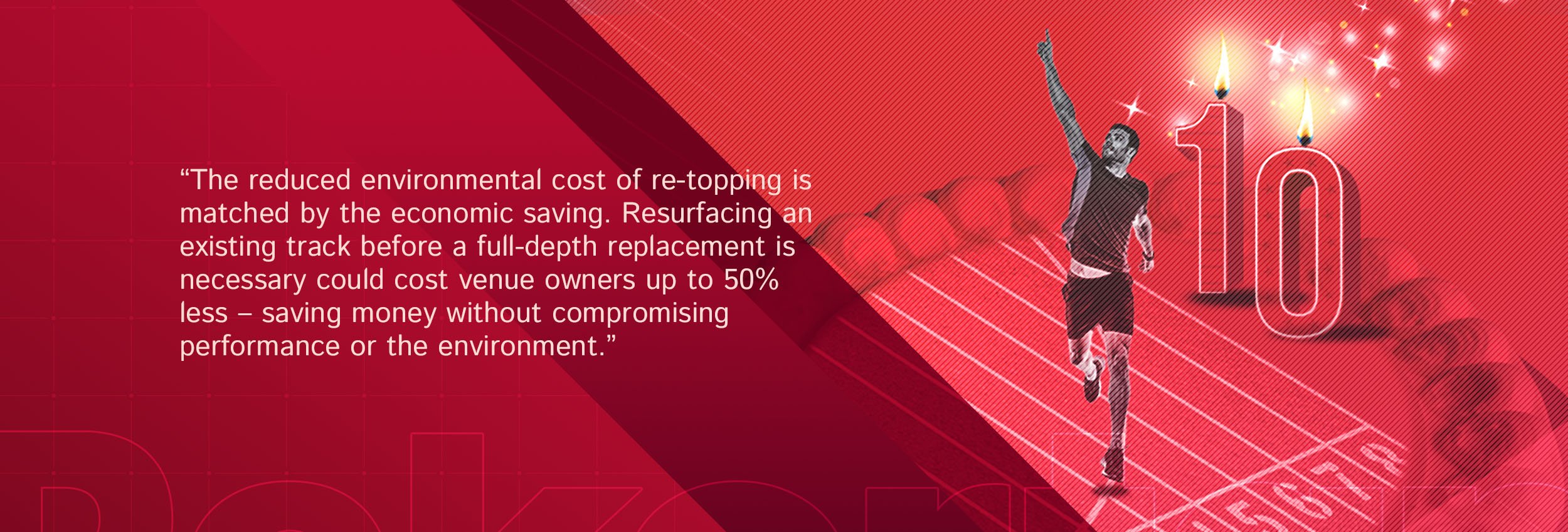Re-top your track and celebrate another 10 years running
Getting tracks up and running again
As the world resurfaces from COVID-19, track venues around the world are starting to spring back into action. The sport facilities that are the heartbeat of so many communities are coming to life again but it has been a challenging time for the health of our cities, schools and stadia. With so many running tracks laying dormant due to the pandemic, the time and budget pressure to get up and running to full speed again is high. For many venues, it is a race for survival.
On track to benefit the environment
The pandemic has also been a stark reminder of our impact on the environment. When the world locked down, the air above China’s Wuhan, cleared. Ditto Venice’s Canals. As production opens up again there has never been a greater emphasis on the need for, and ability of, the human race to reduce its carbon footprint.
This is why, as the world resurfaces from COVID-19, now could be the ideal time to resurface your track.
Rekortan Gel tracks are made from 88% renewable materials so they have always been an environmentally healthy choice. But their green credentials become even more sustainable when the life-span of the track is extended. Re-topping existing track components has a much lower environmental cost as it can keep your track running for an extra 7-10 years.
“Rekortan Gel tracks are made from 88% renewable materials so they have always been an environmentally healthy choice. But their green credentials become even more sustainable when the life-span of the track is extended.”
Keeping tracks running for 30 years or more
In 2020, Rekortan re-topped Wales’ Newport Stadium, injecting new life into a 23 year old surface that is on track to last 30 years as a result.
In Wollongong, Australia, the Kerryn McCann Athletics Track was re-topped from red to blue in 2017, extending its lifespan beyond 30 years.
Re-surfacing to Diamond League Standards
Environmental gains are not made at the expense of performance gains. Our resurfacing projects at the Manchester Arena and Alexander Stadium in Birmingham are proof of this. Both World Athletics certified venues, we have re-topped both tracks and maintained their elite standards over 19 and 20 years respectively.
Safeguarding athlete performance
In terms of athlete performance, resurfacing an old track immediately improves the athlete experience. It restores cushioning, provides optimal force reduction on athletes’ joints and removes any cracks and loose crumb which could lead to falls.
Getting tracks up and running again sooner
Given the weeks and months that COVID-19 has left tracks dormant, the benefit of minimising the time that lanes are left empty can’t be overstated. As well as giving back years in lifespan, re-topping takes a track out of commission for less than a week. If new asphalt is required, completely replacing your track takes at least 30 days. So on average, re-topping ensures that a venue is up and running again five times sooner.
Green tracks cost less
The reduced environmental cost of re-topping is matched by the economic saving. Resurfacing an existing track before a full-depth replacement is necessary could cost venue owners up to 50% less – saving money without compromising performance or the environment.
Track longevity benefits everyone
Choosing a track system that is made of high quality, integrated components that are suitable for the local climate will increase durability. As with anything, good maintenance is also key to a track’s lifespan. Add to this, the ability to re-top that surface before a complete replacement is required and you start to see tracks far outperforming their expected lifespan which is good for venue owners, athletes, local communities and the environment. It is the race that everyone wins.

